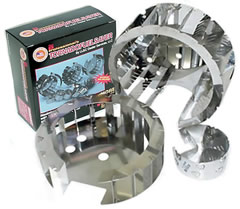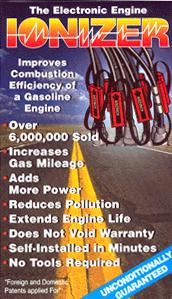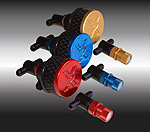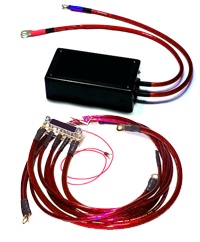The Fuel and Engine Bible - how engines work including 2 stroke, 4 stroke and wankel (rotary) engines, fuel, octane rating, power, bhp, gas types and grades, carburettors, fuel injection, tuning, tweaking, nitrous, turbos, superchargers, chipping, hybrids, how to keep your engine running at peak fitness and much more.
The Fuel & Engine Bible
Fuel additives and retrofit "efficiency" devices
"A fool and his money are easily parted". No saying holds more truth than in the motoring world. There are tens, perhaps hundreds of companies out there all claiming to manufacture devices which give better fuel economy, cut down on emissions, add to engine longevity etc. For the most part, these products are elaborate cons. And in some cases, not-so-elaborate. For as long as people are gullible, and can be led by advertising hype, these companies will thrive.
What you need to consider is one very important question : If these devices work, why do the manufacturers not put them on their cars as standard? Surely selling a Subaru equipped with a device that gives 8% better economy than the equivalent Nissan would be a killer sales pitch?. Well the answer is blindingly simple: these devices don't work as advertised. There's an important distinction there because a lot these devices do something but just not necessarily to the level promoted in the advertising. Often nowhere near that level.
For the lawyers out there, I'm not attempting to be defamatory about these products. I'm attempting to educate. If your company can prove to me that these devices work, I'll happily change my articles. Contact me for where to send free samples to for testing.
Without further ado, then.....
MPG Caps, FFI and all the other "pill in your fuel tank" miracle workers

Status : Tested
Websites : myffi.biz and mileagesecrets.com
MPG Caps, or any of the other "pill in your fuel tank" products are the cheapest and easiest-to-find miracle cures for increased power and gas mileage. The products are simple. They're normally pills, in a pop-out wrapper just like medical pills, or in a bottle. They smell foul and the manufacturers claim that one pill per 20 gallons of fuel will give you increased power and performance whilst at the same time cutting your mpg (in some cases they claim up to 30%). Explanations range from "organic engine conditioner that improves fuel economy and power by creating a micro-thin coating on the combustion chamber allowing fuel to burn better" all the way up to the fantastical "nanotechnology particles that seek out and change the molecular structure of refined gasoline to make it burn more efficiently". Wow. Impressive stuff. Typically these pills are biodegradable plant or sugar compounds laced with food colouring and some odd petrochemical to give them an official smell. They don't work.
ABC reported on a AAA test of the MPG Caps and found their claims to be invalid.ABC report.
Texas recently closed down Bioperformance Inc. for fraud linked to their magic fuel pill: Report.
For my test of the MPG Caps fuel pills head over to my Product Reviews page.
The MPT SmogBuster™

Status : Untested
Websites : fueldisc.com and/or fuel-disk.net
If I started this paragraph by telling you that a device projected "holographic frequencies into the gas tank and changes the molecular structure of the gasoline" what would you think? Well it seems that plenty of people think enough of that statement to cough up $299 for a plastic disc with some fancy silk-screen printing on it. The idea is, apparently, that the molecularly-changed fuel burns more efficiently thus giving you better gas mileage and less emissions. It's about the size of a US quarter or a UK 10p piece and is supposed to - wait for it - be taped to the underside of your gas tank. The website even helpfully suggests that superglue could be used.
From the Denverpost.com :
"It doesn't work," says Dr. Terry Parker, a physics professor at the Colorado School of Mines. Parker and graduate student John Dane of the chemistry department tested the device for 9News. "It's clear that it's just a sticker and nothing else," Dane said.
What should set alarm bells ringing with this device is that it's sold through multi-level marketing, the new buzzword for pyramid selling. The more of these units you sell, the cheaper they get for you to buy.
The best part of the sales pitch is this section :
OceanCity Network, Inc. is proud to offer a 30 day 100% money back guarantee if not completely satisfied. To qualify for a full refund, the MPT SmogBuster™ must remain adhered to the paper in which it was shipped on..
So if you unstick it and use it, you can't get your money back. However, they add that to test it, you can simply duct-tape the thing to the gas tank, complete with it's backing paper. So even if the device was electrical (which the silk-screen printing might lead you to believe), putting a piece of paper in the way would prevent it from making any contact with the metal of your tank. I also suspect that trying to remove the duct tape from the fuel disc without removing the fuel disc from the backing paper is going to be next to impossible. One last point to note : most fuel tanks are covered in a rubberised underseal protection - there's no metal to stick this thing to in the first place.....
The Tornado Fuel Saver

Status : Tested
Websites : tornadofuelsaver.com
This thing is known by many, many different names, including the Cyclone-Z Fuel Saver and the Dynamix Fuel Saver. The basic premise is to make you believe that by swirling the air in your intake manifold, you'll get a better fuel-mix which will result in cleaner burning, longer-lasting, more emission-friendly engines, that at the same time give more horsepower.
It's a great theory, and for $69, who could resist? The theory is sound. So sound in fact that carburetors and fuel systems have been swirling the air in the intakes for decades. It's called the venturi effect and it's why carburetors can freeze up in the winter.
John Matarese of the "Don't Waste Your Money" website has a good writeup of a Tornado review. You can find it at this link. His results? Less than a 1% increase in fuel economy. Not quite the 20-30% promised.
The US E.P.A has not tested the tornado fuel saver, but after testing more than 100 similar products including the Cyclone-Z (report PDF) and the Dynamix (report PDF), the E.P.A says it "has not found any product that significantly improves gas mileage."
Let's face it. If these things really worked, GM, Ford, Volvo, BMW and all other manufacturers would be buying them by the millions, and cars would come out of the factory with them on. And speaking of the factory, bear in mind that most car manufactures can and will use an engine add-on as a reason not to honour your warranty.
For my test of the Tornado, head over to my Product Reviews page.
Magnetic Fuel treatments
Status : Tested
Websites : too many to list.
If you drive a car, you're absolutely guaranteed to have heard this claim before : "put a magnet on the fuel line and it will increase your fuel economy by making the fuel burn more efficiently." There's many reasons that these devices typically don't work. Here's just a few of them:
- The magnets are tiny, and pretty weak. A magnet cannot provide oxygen and neither can it change the amount of heat released from burning the fuel. It can effect the fuel through diamagnetic influence but that's never been proven to have any measurable effect on gas mileage.
- Liquids cannot "retain" any magnetic effect when they leave the magnet, even if affected when within it. Hence you cannot "charge up" a liquid in the way that a dust particle can be charged.
- There is no truly independent lab analysis which could give evidence that combustion can be improved nor that you'll get better power output or lower emissions.
The Electronic Engine Ionizer

Status : Untested
Websites : Engineionizer.com
This is an interesting device that takes a different, but similar doublespeak approach to making you believe you can get better fuel economy. Their device consists of a jumble of wires connected to plastic blocks which clamp around your spark plug cables. This is directly from their description:
When a spark plug fires, the capacitor block attached to each spark plug wire picks up a high voltage, low amperage charge (sometimes called a "Corona Charge"). This charge is transferred from the firing cylinder to the other non-firing cylinders via the harness wire. These charges cause a partial breakdown in the larger hydrocarbon molecules in all the non-firing cylinders, resulting in increased combustion efficiency. This translates into better fuel mileage (economy), more horsepower, easier starting, less pollution (lowered emissions), smoother idle.
Let me decode that for you : they claim to fire the spark plugs in the cylinders that don't need firing. The spark is supposed to cause a breakdown in the gas left in the cylinder which somehow makes the next fuel/air charge burn more efficiently.
First of all there's the deviously misused definition of "corona charge". That's actually a wire which emits a static electric charge in a halo around itself. It's normally used in reference to laser printers (!) If spark plug wires did this, you wouldn't be able to hold them whilst the engine was running, nor would you be able to have them touch or be near anything metal in the engine bay. If they were constantly generating static electric charge, you'd also not be able to listen to your radio either. So seeing that caused me to want to work through the rest of the description one step at a time.
- A capacitor block picks up a charge from the spark plug cable. Hmm. Well a capacitor stores charge - it doesn't pick it up. For a capacitor to get any charge at all, it would need to be physically wired in to the spark plug circuit. So instead you'd need an inductive loop. Inductive loops generate current because of Faraday's law - it's all to do with magnetism. The brief pulse of current through the spark plug cable generates a magnetic field. The coil of wire sitting inside the magnetic field induces current in its own circuit.
- The charge is transferred to the non-firing cylinders via the harness wire. Actually it isn't. The induced current is transferred along the harness wires to the other inductive loops. The result is a brief inducance back into the other spark plug wires, but at a reduced amount due to resistance in the wiring. The current induced in the other spark plug cables would be nowhere near enough to fire the spark plugs. But lets' give them the benefit of the doubt again and assume the other plugs to spark.............
- These charges cause a partial breakdown in the larger hydrocarbon molecules in all the non-firing cylinders. (sigh). Ok - the charge isn't doing anything to the cylinders at all. The spark plug might be sparking, but even if it is, given the basic design of a 4 stroke engine, there is nothing to burn in the cylinders unless the fuel-air mix is in there. In fact, trying to initiate a spark too early could result in detonation, which would actually damage your engine.
Honestly if this idea had any merit, it would be a lot simpler to just wire all the spark plug cables together so they all fired every time one of the cylinders reached it's firing position. Think of how much simpler engine timing would be!
Sadly for EngineIonizer, there's a reason why engine manufacturers only fire one spark plug at once. Although having said that, one reader did contact me with the following snippit of information:
On the subject of The Electronic Engine Ionizer, you say "there's a reason why engine manufacturers only fire one spark plug at once". As a small note, some manufacturers have simplified ignition systems (Yamaha's YZF-OW01 and YZF-R1 come to mind) which fire cylinders in pairs - one near TDC of the compression stroke and one near TDC of the exhaust stroke. When I did a little work with Kingston Kawasaki (a BSB privateer team) we switched over to this system: there was no power gain, about 1.5 kg weight saving and the spark plug life dropped by about a quarter. I've only ever seen this in 4-cyl engines, although I think some early British twins did this too.
That in turn resulted in another email from another reader:
I used to own a 1979 Yamaha XS650 (twin cylinder Triumph ripoff, if you don't know them) with electronic ignition. It had a 360 degree crank, so Yamaha figured there was no harm in having the sparks go off each rotation so that's what they did - every time the cylinder went past TDC there was a spark, whether it was a compression or exhaust stroke. Cheap to manufacture but it had no effect on fuel consumption or power.
The Ecotek CB-26P

Status : Untested
Ecotek PLC are marketing a device in England which clamps on to your intake manifold. According to the doublespeak on their site, this device improves performance by collapsing the manifold vacuum so that when the throttle is reapplied, there'll be slightly more fuel in the air-fuel mix and that will improve the throttle response. The hype also claims that the device creates greater turbulence and swirl, which promote better suspension of fuel molecules. And finally, the all-encompassing claims of better fuel economy, better acceleration and more power are all present and correct.
One slight problem. This device claims to work during overrun - when you take your foot of the accelerator and the car uses engine-braking. In those conditions, 100% of modern fuel-injected cars cut off the fuel supply. And on older carburettor engines, there's no proof this device does anything at all. In fact there's so little proof that this product has been complained about enough in England to reach the advertising standards authority. You can read their report on it here. In short : waste of money. Once again ask yourself the same question : (all together now) "If it's so good, why don't manufacturers fit it to their cars as standard?"
The "+20bhp chip" conversion
Status : Untested
This is a great scam doing the rounds of ebay in Europe. Search for "mod + 20 bhp" and you'll see literally hundreds of these things going very cheaply. (Better still click here to pop up a new browser window with the search in it). If you are suckered into buying one of these, you'll get a kit containing a resistor that you connect to the positive line of your air intake temperature sensor. The idea is that it fools the ECU into thinking the air charge is colder than it actually is. So why does they claim this works? The claim is that the ECU will be fooled into increasing the fuel in the fuel-air mixture making the engine rev better, and adding 20bhp to the power.
Of course like all these scams, that's not quite the case. First of all, it's the air which would make the engine run better, not the fuel. That's why turbos and superchargers push more air into the cylinders. By running more fuel, you basically run a richer engine which makes the engine run cooler. As well as that, all EFI engines have lambda sensors to measure the actual fuel-air ratio and the ECU takes this reading and adjusts the fueling accordingly. It doesn't simply do it from the intake air temperature. So if you fit one of these devices, this is what happens:
1. The ECU gets a reading from the IAT, and adds more fuel.
2. The Ecu then gets the actual fuel-air ratio info from the lambda sensor, realises it's over fueling and cuts the amount of fuel it puts in.
3. The cycle repeats until the excess fuel totally destroys your expensive catalytic convertor.
4. The ecu will also adjust the igniton timing everytime it gets new info. This means the ignition map is constantly changing which could eventually cause the engine to knock/pink, but will certainly make it run rougher than a tractor.
As with most of these scams, there's a Q&A associated with them designed to make you believe the device will work. In this case, it looks something like this. I've debunked each Q&A on a per-item basis.
What is this Device? It is a resistor chip that gives out a constant reading of air temperature to your ECU.
Sorry, it isn't. It's a 40¢ resistor that lowers the voltage coming from the sensor. A chip is made of silicon and has many layers of circuitry laid out in it, and it requires a special plug - similar to the chip inside your PC or the ECU in the car.
Will my car accelerate faster with this electronic device? Yes! This is the whole point! It has been dyno proven that this device will add up to 20 HP to your vehicle!
Really? Because the dyno graphs on e-bay are so obviously faked that I'd believe an untrained 3-year-old could do a better job. I'd like to see actual proof of this from a reputable dyno shop.
Will this device damage my car? Absolutely not. Since the altered signal will always stay within the manufacturer's specifications, there is no way for your engine to get damaged in any way.
Yeah - not technically true. You are fooling the engine into thinking it has a cooler air charge, therefore the fueling will be altered beyond the manufacturers specification for the given air temperature, and that could damage your engine.
Like I've said above in this page - if this really worked, why wouldn't the car manufacturers simply re-map their ECUs to perform like this? Or add this resistor to their circuits themselves? Simple - because it does not work.
Voltage stabilisers and grounding kits

Status : Untested, but I've been in contact with the manufacturer
I've seen a few websites kicking around that advertised massive benefits in fitting their voltage stabilisers and grounding kits to vehicles. Votech Performance is one such company. Their doublespeak (in very poor English by the way) is technically correct. If you connect a car alternator directly to the battery and run all the electrical circuits off it, then you're going to be subject to high-frequency noise in the power supply as well as fluctuations in voltage due to engine loading. They're also correct in asserting that a voltage stabiliser kit and some decent grounding connections will help minimise these issues. What they fail to mention on their website is that almost every new car on the market today (and probably since the mid 90's) has a voltage stabiliser in it. Basically it's a collection of passive components (ie. that draw no power) like capacitors, arranged such that any voltage spikes can be capped off, and the high frequency noise can be reduced. For the grounding wires, check under the hood of your car. Those gigantic copper braided cables connecting the battery and engine to the body of the car and the fusebox are your grounding cables. Pretty significant sized cables too. The reason for these bits is the ECU - vehicle manufacturers don't want random power fluctuations reaching the sensitive electronic components in the engine management system. By default, the inclusion of any sort of chip-based engine management means the manufacturer must include voltage stabilisation in their electrical system. So - outfits like Votech are entirely correct in their assertions, but miss out the important fact that your car already has the stuff they're selling.
However in July 2006, Votech contacted me directly to address some of my comments here. What wasn't clear from their website, but has been made clear since, is that Votech's target market is for local Malaysian-built cars, Korean cars (except for Kia and the Hyundai Sonata which has voltage noise suppression from the factory) and Japanese cars for the Asian market. It seems the standards of manufacture with their vehicles are so poor that the electrical systems are all over the place, and there's a lot of difference between Japanese cars for the west versus those for the Asian markets. What Votech are selling is basically what the Malaysian manufacturers don't put in their vehicles as standard but what we in the "west" take for granted. Their marketing guru told me "We advise our customers before we sell to them. Customers who driving BMW, Merc, Audi, Fiat, VW and other continental cars are advised that our product isn't necessary. If a customer insists they want it, then we will proceed with the installation."
OK so now with that in mind, when we look at the claims, whilst they read pretty poorly to anyone with an American, Japanese or European car, I can imagine for Votech's target market they might actually make sense. Votech tell me that they can provide anyone who asks with independent lab results gained from dyno testing.
- Increased Torque - how? Votech claim that the better voltage response in the low tension circuit results in better response in the high tension circuit. This could result in a more powerful spark which might give a better burn in the combustion chamber. It's possible on Malaysian-built cars then that this would result in more torque.
- Better throttle response - this is all to do with how the engine sensors read their data and send it back to the ECU. If they're getting crappy, noisy voltage, then the readings being sent back to the ECU could be all over the place, meaning it could have trouble generating good throttle position information from the engine map. If the sensors are allowed to do their work properly, the ECU might be able to do a better job of mapping it all out, and the result could be better throttle response.
- Brighter headlights - this could be true except their product would need to be generating either more than 12v or higher current. Well again you need to look at it from the perspective of their target market. If their cars have headlights that get brighter the more you rev the engine, then Votech's product could stabilise the voltage and give a more consistent light output.
- Improved audio quality - now this one I could go with, especially if you listen to AM radio. But again, most modern Euro, Japanese and American cars have stabilisation and noise-suppression built into the factory 12v system.
- Improved Fuel Efficiency. Fuel efficiency would seem to have nothing to do with the 12v electrical system. But technically, the alternator is in the 12v electrical system, and load on the alternator can affect fuel efficiency by adding mechanical drag to the engine. The more load on the electrical system, the more drag in the alternator. The difference between a shoddy 12v system and a decent one can be up to 3% in fuel efficiency.
- Colder air-con - this is a bit of a wild claim. The a/c compressor is belt-driven off the engine crank. The only electrical component is the fan that blows the air into the car, and that doesn't make the air colder, it just moves it around. However Votech reported to me that they did get a 2°C drop in temperature coming out of the vents on their Alfa test vehicles. Quite why this would be, I don't know.
Further insight
I was contacted in 2011 by Ricky Willems, a senior electrical engineering and product design major at Rensselaer Polytechnic Institute, a member of SAE and IEEE. (His extracurricular work includes designing hybrid electric race cars and vehicle ECUs). He had some insight into voltage stabilisers:
I own a Pontiac Montana van that has gone through 3 separate stock voltage stabilizers. The electrics were poorly implemented, and water has repetitively damaged the electronic controls. In addition, I have been in situations where the jiggling of grounding wires brings the voltage back into regulation temporarily. Because of these failures, Ive had opportunity to judge the effects of having or not having a voltage stabilizer on a modern EFI car that was designed to operate with one. I imagine this would be a similar situation to asian market cars that did not include one, despite having an otherwise similar design to western models.
The only claim I cannot support that you list is the colder AC, which I have not noticed, but then again likely wouldn't as I don't use AC very often anyway.
I can support increased torque, Better throttle response, and Improved Fuel Efficiency. The voltage variations send rippling voltages to the cars sensors, which then report back flawed data to the internally regulated ECU. The engine can normally adjust for errors, but since the errors are transient and continuous, the ECU cannot adapt. As such, according to my OBDII connection, the values reported vary from what they should and impact fuel mixture negatively, causing a loss in torque, loss in fuel economy, and strange (though not "slow") throttle response.
Audio quality on my vehicle has not been impacted, as it is also internally regulated, but I have had stereos on vehicles with no regulation that suffer severely for it. Many vehicles, even with a solid voltage stabilizer system still have too much noise for after-market stereo systems to sound clear and interference free.
As for brighter headlights, the claims are half true. When my regulation is off, the headlights flicker severely with the pulsing of the alternator. The appear dim, although each flash is actually brighter than the headlights would regularly be. The flashing makes it appear otherwise though. (your eyes adjust to the brighter light output, only to have it taken away 50% of the time)
My only -guess- on the air conditioning is that it may make it cooler at idle, when the more properly running engine would smooth out its idle, and have a more consistant AC output. Mind you its only a guess.
Resources for the curious
There is an excellent site which covers all the above and a lot more with engineering and scientific analysis of all these products. If you really think they work, then drop in at fuelsaving.info and find out how clever the marketing hype is, and how little any of these devices actually work.
The FTC have a page dedicated to warning the public about these scams. Click here for the FTC's "Gas-Saving" Products: Fact or Fuelishness? page.
The Environmental Protection Agency (E.P.A) has evaluated or tested more than 100 of these alleged gas-saving devices and has not found any product that significantly improves gas mileage. In fact, some "gas-saving" products may damage a car's engine or cause substantial increases in exhaust emissions. Click over to epa.gov and put "gas saving" in their search box.
One of the best sources of information on the E.P.A site is their page on Gas Saving and Emission Reduction Devices Evaluation.. Here you can find downloadable PDF reports on everything from the FuelXpander to the sexually deviant-named Analube Synthetic Lubricant.
EPA Evaluation of Aftermarket Gas - Saving Products (PDF)
EPA Motor Vehicle Aftermarket Retrofit Device Evaluation Program (PDF)
Environmental Fact Sheet: Aftermarket Gas Saving Products and EPA Product Evaluations (PDF)
Tell me more
If you've got a device you've bought and tested, or you'd like to know more, drop me a line. The more of you that contact me, the more complete this page will become.
